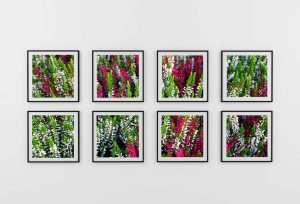Last Updated on January 10, 2025 by teamobn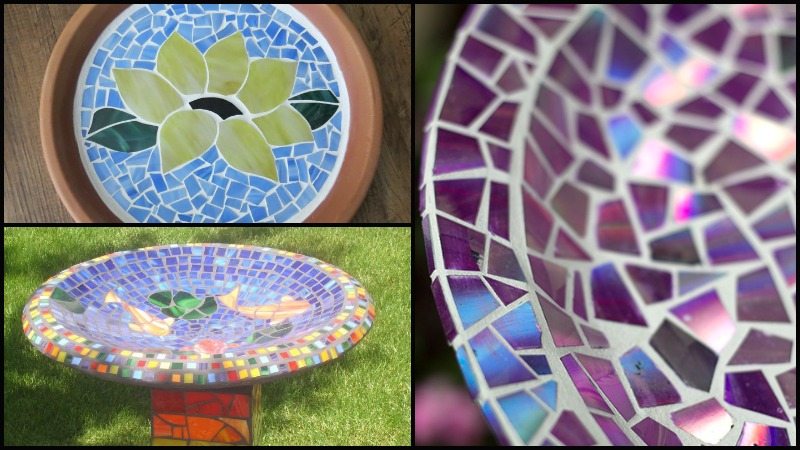
Don’t know what to do with that old CD collection you don’t need anymore? Use them to attract birds to your garden by making a mosaic bird bath!
Mosaics were originally created to decorate buildings. They are created using small pieces of coloured stone, glass, or tile.
These small tiles can be arranged to create a picture, which can then be used to decorate floors, walls, and ceilings. But not only these, it can also be used to create a beautiful piece of art.
Bird baths, or birdbaths, are small garden pools that are filled with water for birds to drink and bathe in. They are typically fashioned from bronze, copper, cast iron, or stone and shaped like a shallow bowl.
But did you know that you can create a beautiful mosaic bird bath? Mosaic bird baths are best inclusion to your garden. 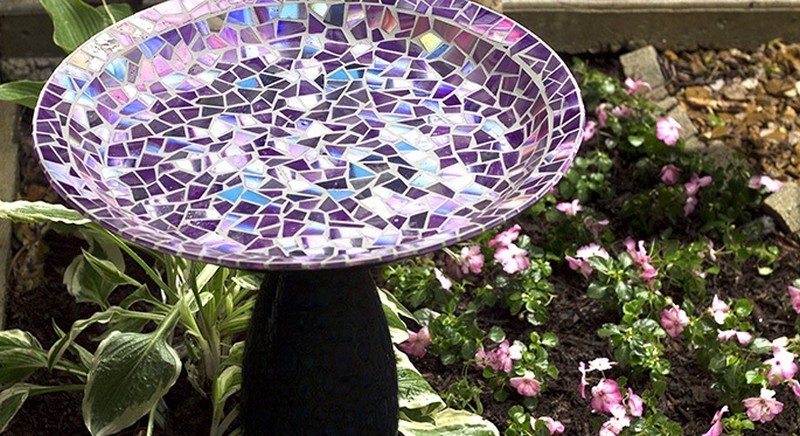
Various materials use to create Mosaic Bird Bath
CD and DVDs
As I mentioned earlier, you can use various materials for a mosaic, but your old CD and DVD collection can be put to a good use when it comes to art.
CDs have a wonderful tint that is sure to make your bird bath stand out in your garden. CDs do in fact make a great garden decor. They have inlaid copper and silver and look like rainbows and fireworks in the water. The water reflects their multi-colored light and it is really pretty.
It’s an easy garden decor project that even lets you restore broken terra cotta saucers and turn them into something more beautiful!
Already used up all your DVD’s and CD’s for a different project? You can use other materials you might find in your storage, such as coloured glass or broken tiles.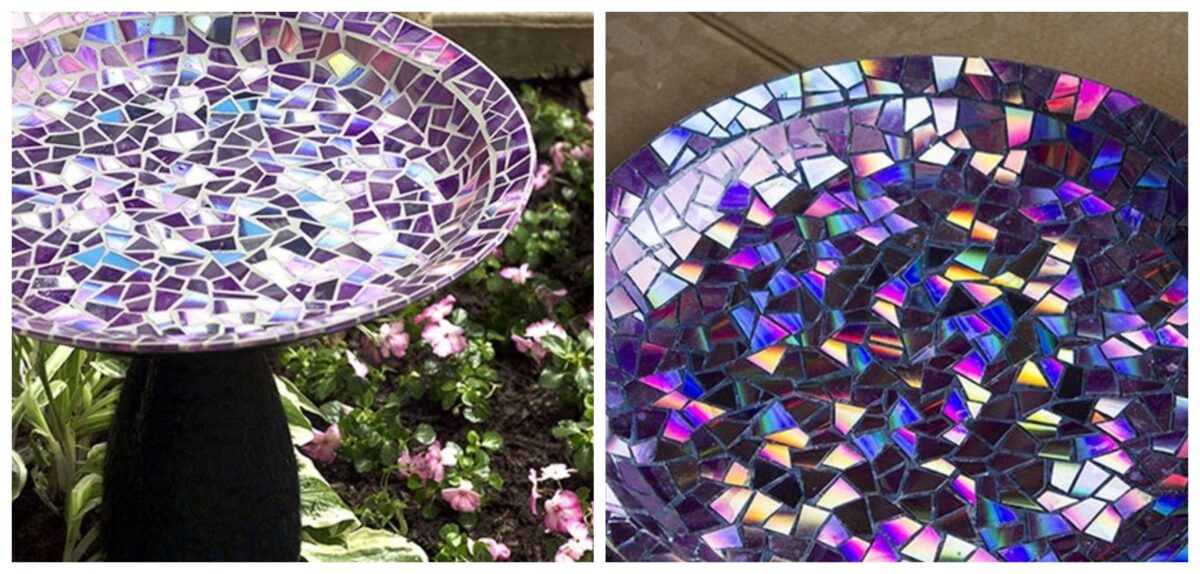
Broken Tiles
Do you have extra unused tiles from your previous project? Do you have problems of storing them? Then you might want to consider making them mosiac bird bath pieces.
Doing some creative touches in your outdoor garden can give a unique touch to your backyard, you can use broken tiles to create a mosaic bird bath.
It is a great way to give new look to your outdoor area, it can be done in a classic or contemporary style. It would be interesting to give a unique look to the bird bath using a broken tiles.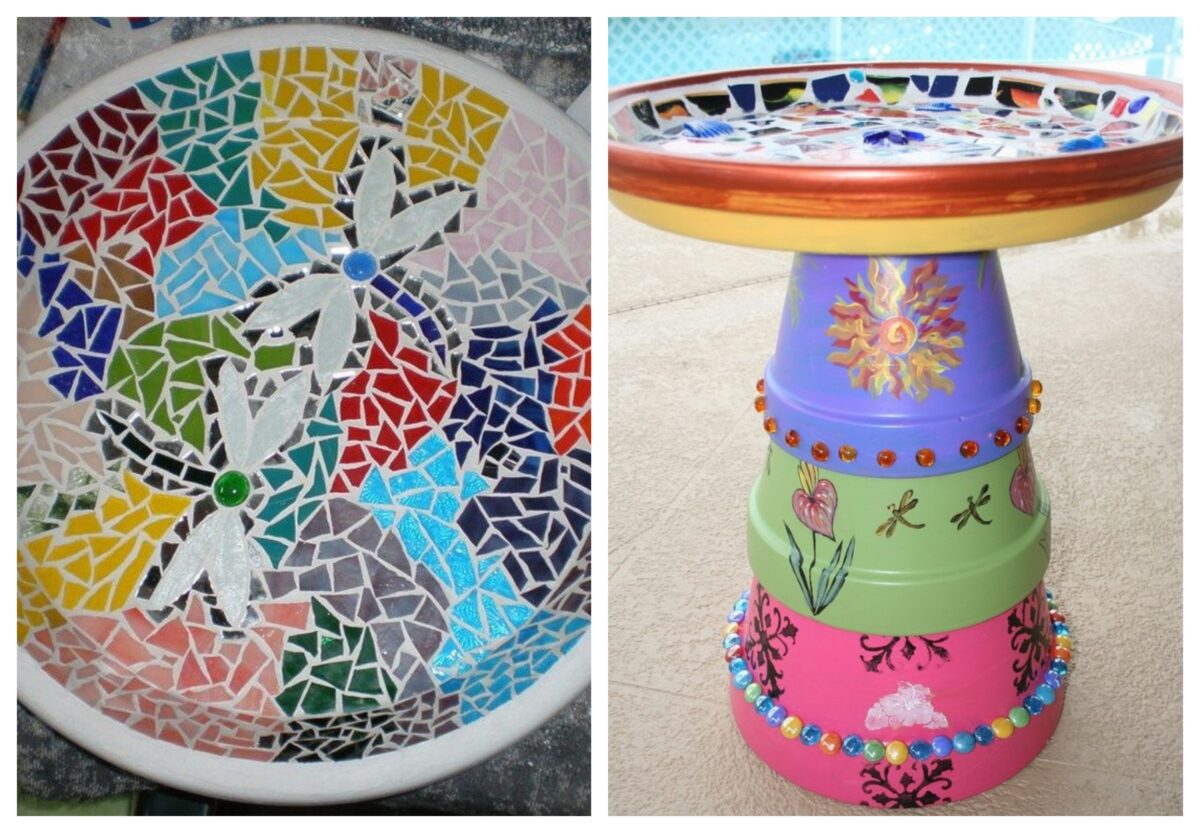
Broken Glass
You can create a vivid mosaic bird bath. Choose colorful broken glass pieces of mosaic and use them to create a bird bath. This is not just a look of art but also a very functional bird bath. People can also use this to create a beautiful garden.
Stained glass is painted glass, typically used to decorate churches, and is a type of glass art. Glass artisans use stained glass painting techniques to create beautiful, intricate works of art.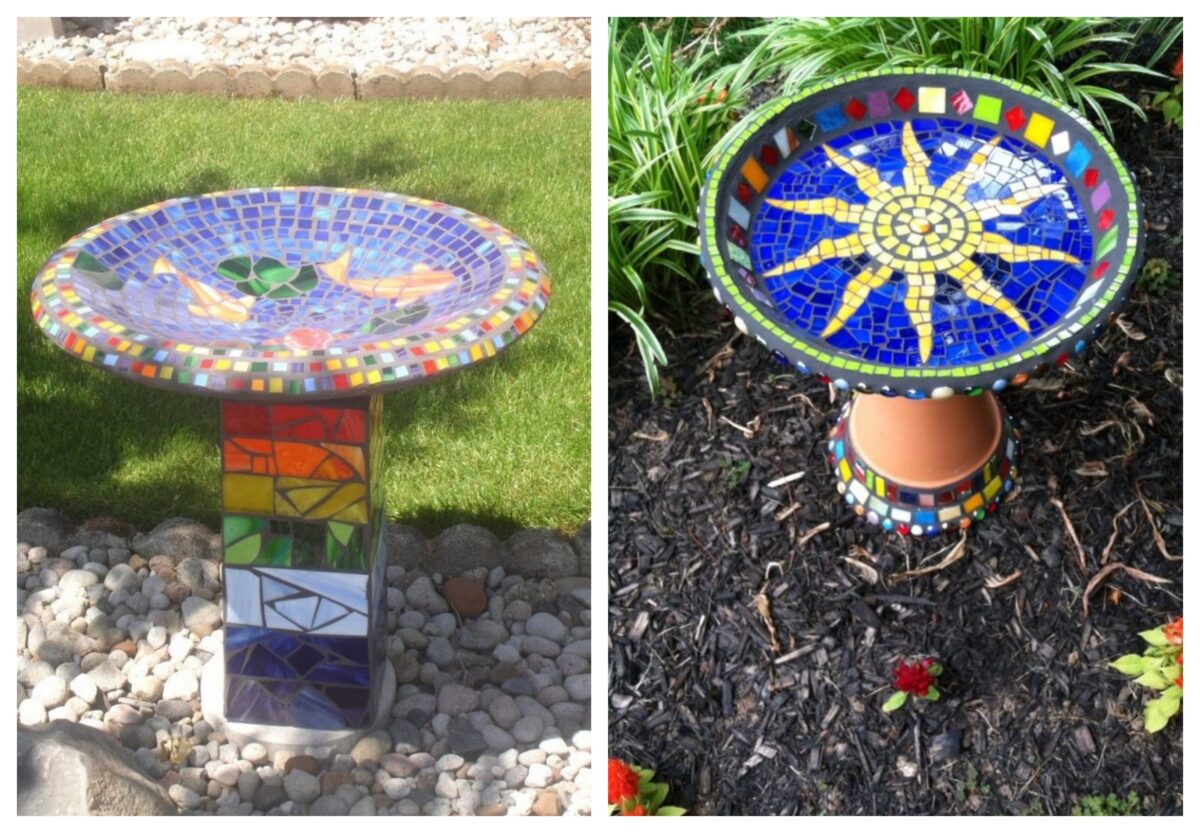
Bird baths bring wildlife into a garden or backyard. These bathing boxes provide birds a place to get out of the elements. They are easy to maintain and have a myriad of uses. They are easily placed in a garden or yard.
Could your garden use one of these amazing bird baths? Then you can be creative as much as you can. These mosaic bird baths will surely be a hit! So grab your desired materials and start creating one!
Building a Mosaic Bird Bath
Materials
- Terra Cotta Saucer
- Old DVD / CD’s
- WaterWeld Epoxy
- Crystal Clear Spray
- Liquid Nail
- Old Tiles
- Broken stained glass
Tools
- Scissors
- Putty Knife
Instructions
Step 1: Prepare Your Materials
- Start by carefully washing your terra cotta saucer to get any grime or grease off. dry it entirely.
- With scissors for the CDs and a putty knife or another blunt tool for the tiles and glass, break the DVDs/CDs, old tiles, and stained glass into smaller pieces. To guard your hands, don safety gloves.
Step 2: Design Your Pattern
- To complete your mosaic design, arrange your shattered bits on the saucer without gluing them down. To design a visually appealing pattern, think on color choices and location.
Step 3: Apply Adhesive
- Lift each piece gently once your pattern is set and dab a tiny bit of Liquid Nail on the underside. Revers it back on the saucer. Work your way outward starting from the saucer’s center.
Step 4: Let It Set
- Following manufacturer advised drying times, let the glue completely dry to guarantee all pieces are firmly adhered.
Step 5: Apply Epoxy
- Prepare the WaterWeld Epoxy according to the package instructions. Use the putty knife to apply the epoxy over the entire mosaic to fill in the gaps between the pieces. This will not only secure them further but also create a smooth surface for the bird bath.
Step 6: Clean Up
- While the epoxy is still wet, clean up any excess with a damp cloth. Be careful not to disturb the arrangement of your mosaic pieces.
Step 7: Cure and Seal
- Allow the epoxy to cure completely; this might take several hours or overnight, depending on the product specifications.
- Once cured, spray the entire surface with a layer of Crystal Clear Spray to seal the mosaic and make it water-resistant. This will also give it a glossy finish and enhance the colors of your mosaic.
Step 8: Final Touches
- After the sealant has dried completely, your mosaic bird bath is ready to be used. Place it in your garden and fill it with water.
Step 9: Maintenance
- Regularly change the water in the bird bath and clean the saucer to keep it attractive and hygienic for birds.
Click on any image to start lightbox display. Use your Esc key to close the lightbox. You can also view the images as a slideshow if you prefer 😎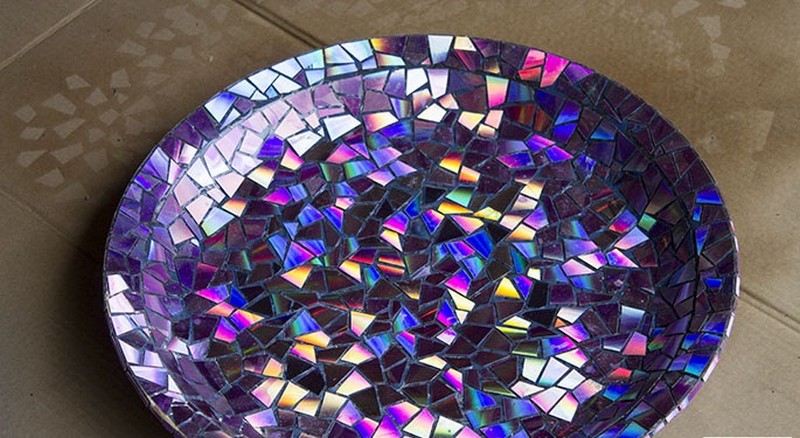

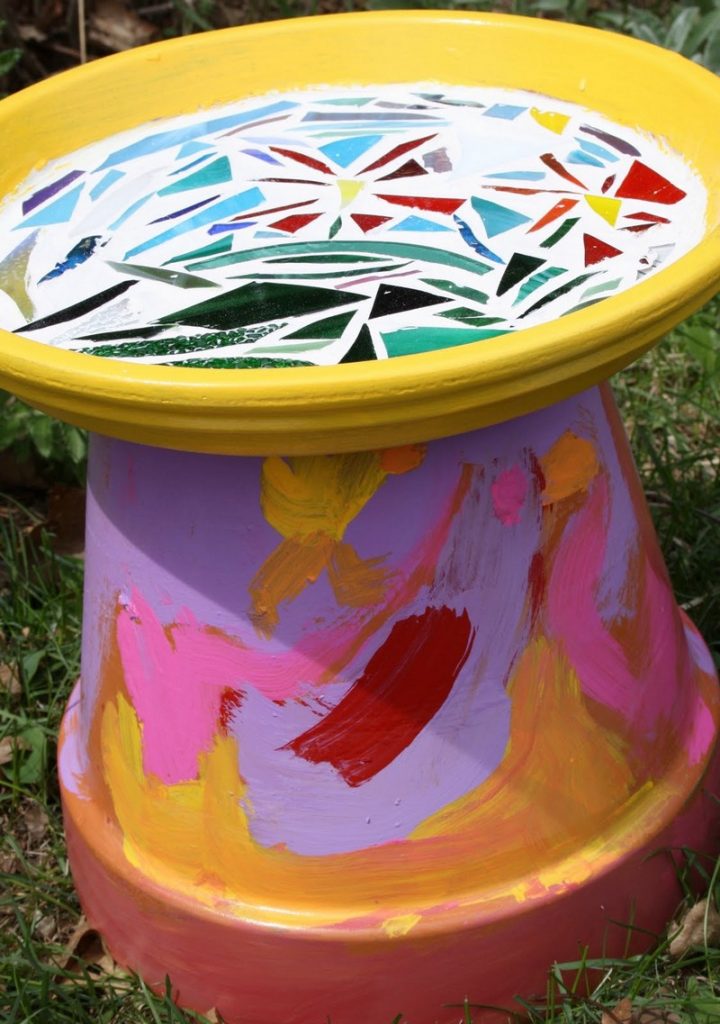
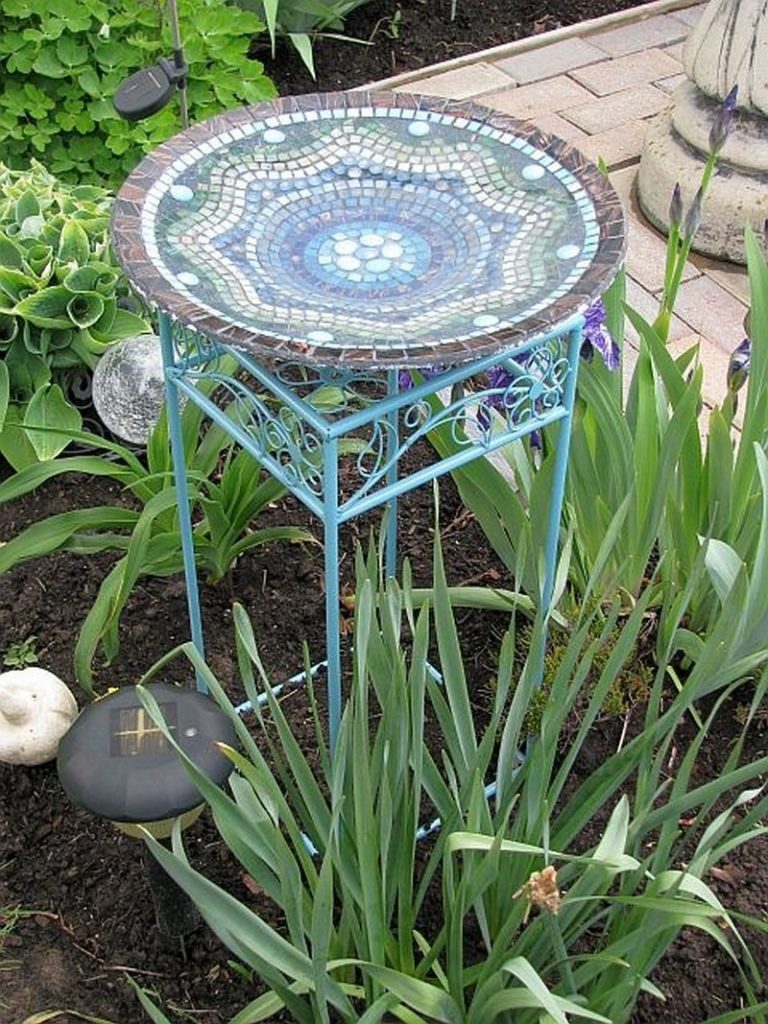
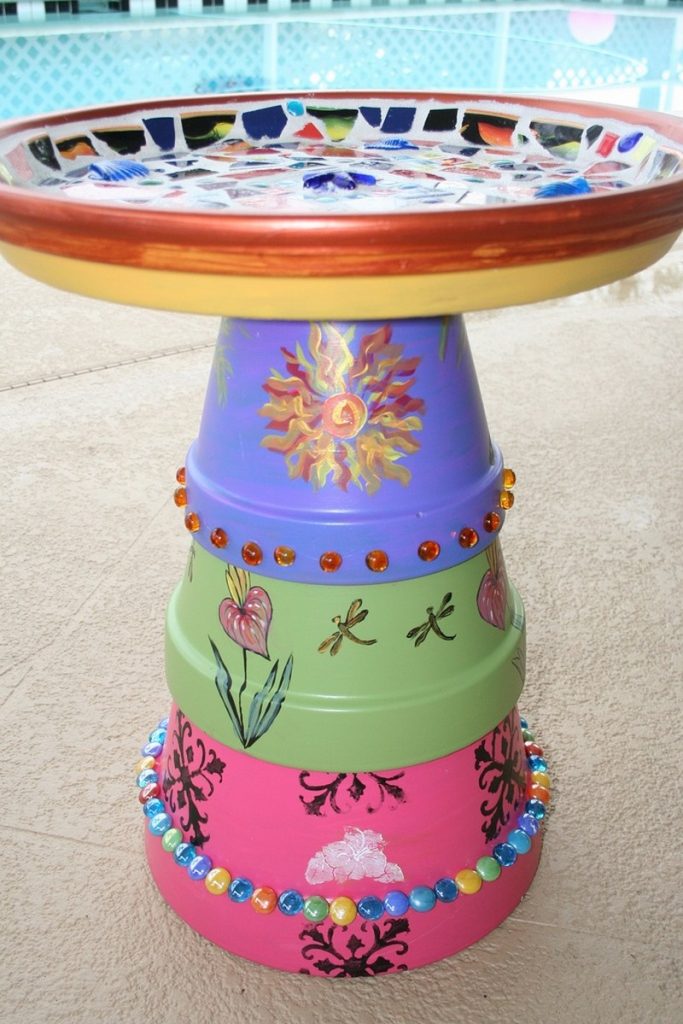
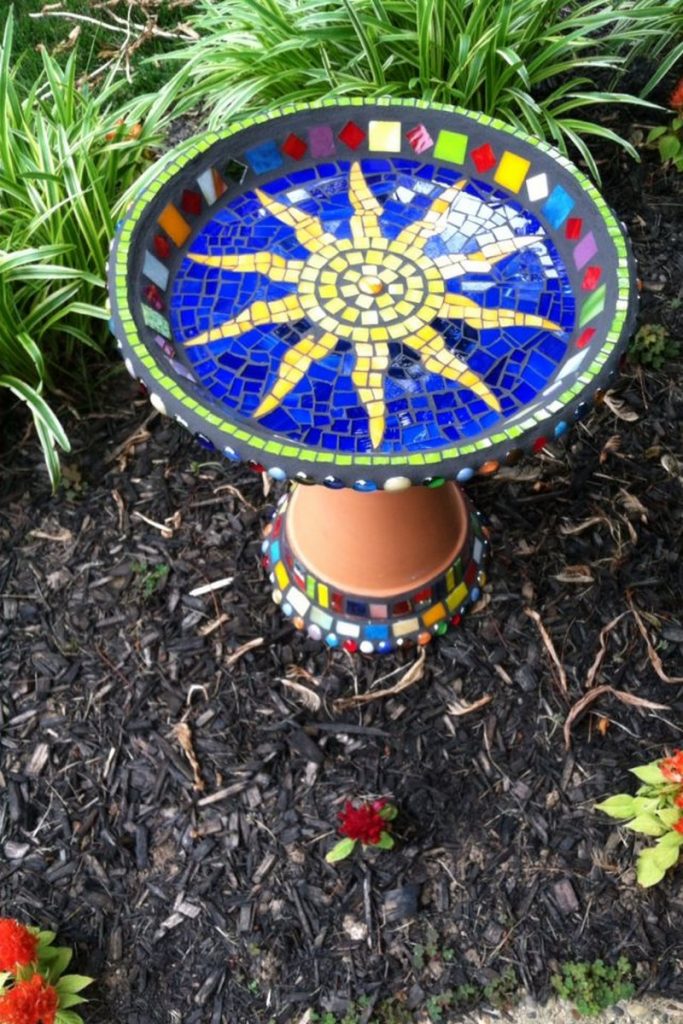
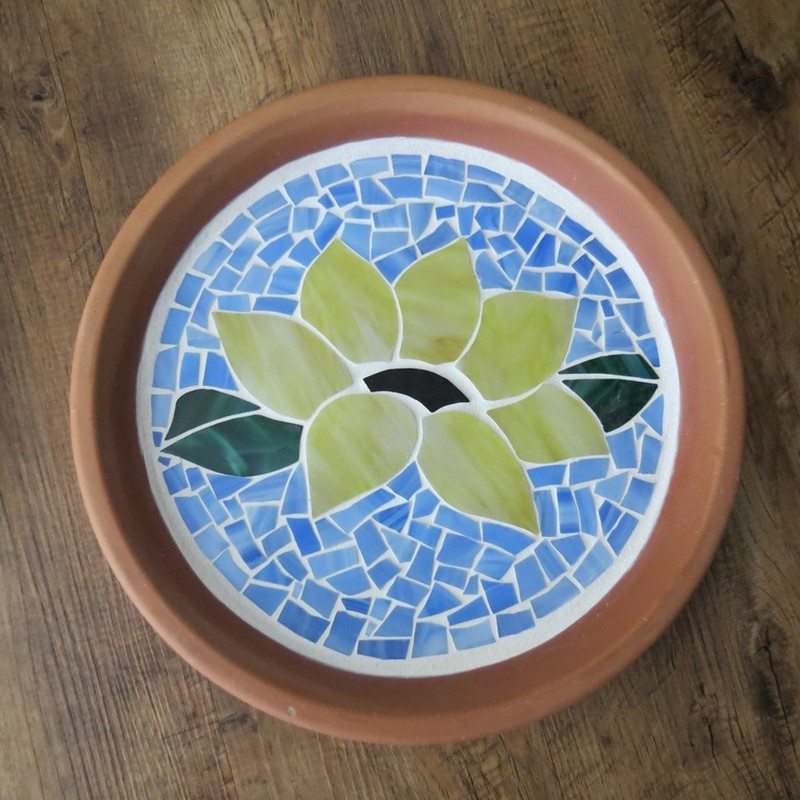

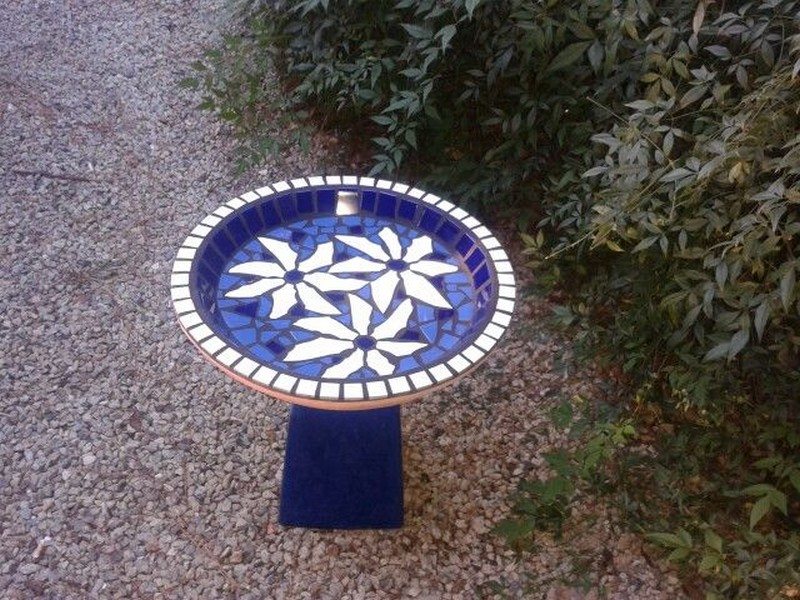
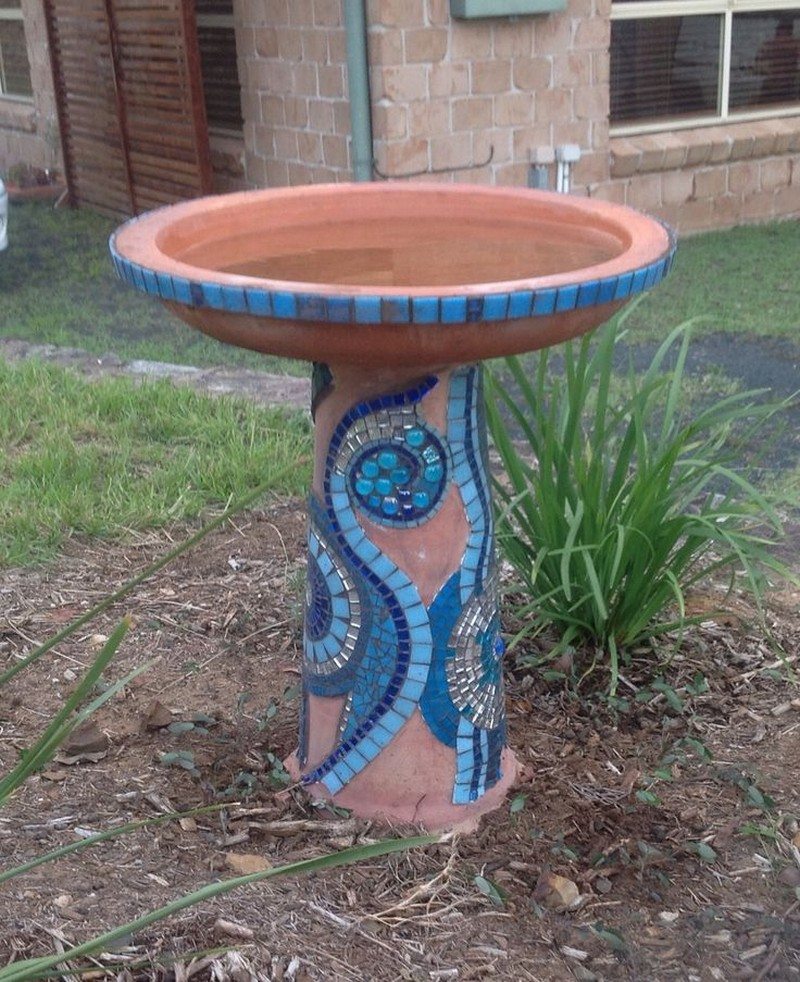

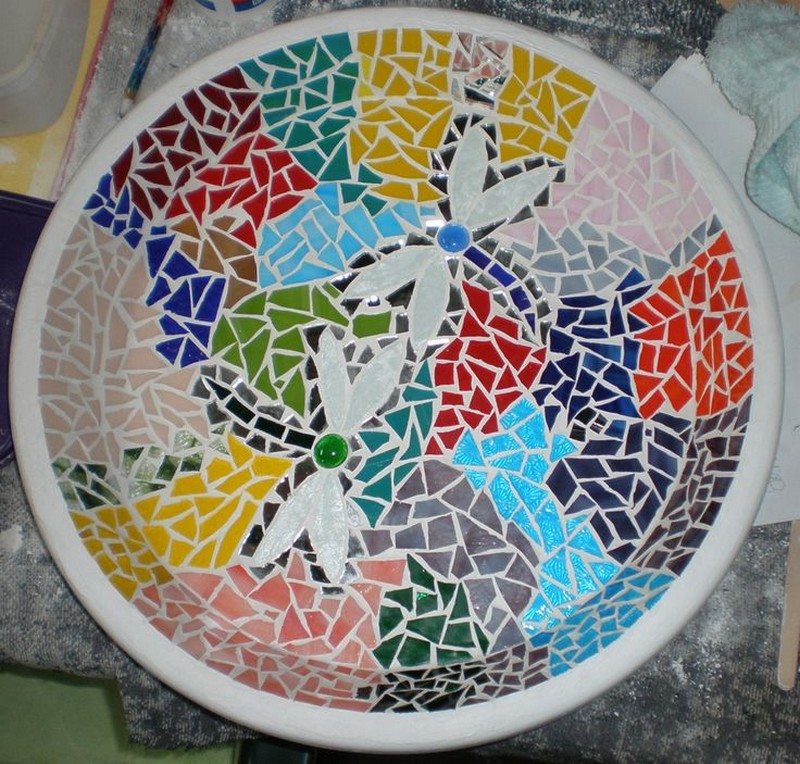
You can get more step-by-step instructions here…
Benefits of Bird Baths to Local Wildlife
Bird baths are more than just charming garden ornaments; they are vital resources for various wildlife, especially in urban and suburban areas where natural water sources may be scarce. Among the different styles available, mosaic bird baths not only enhance the aesthetic appeal of gardens but also serve as crucial hydration and cooling stations for birds and other creatures.
Let’s explore the multiple benefits that bird baths, particularly mosaic bird baths, offer to local wildlife.
Attracting Diverse Bird Species
- Encourages Bird Diversity Mosaic bird baths attract a wide variety of birds, from common backyard species to more rare and migratory birds that might not otherwise visit. The sight and sound of water draw them in, providing opportunities for bird watching and photography. Regular visitors might include songbirds, hummingbirds, and even birds of prey stopping by for a quick drink.
- Supports Migratory Birds During migration, birds face arduous journeys and often traverse urban areas where natural resources are limited. Mosaic bird baths serve as critical rest stops where birds can replenish and rehydrate. Providing water can be just as important as providing food, especially in spring and fall migrations.
Enhancing Bird Health and Hygiene
- Improves Hygiene and Health Bird baths allow birds to bathe, which is essential not only for feather maintenance and cleanliness but also for parasite control. A clean and well-maintained plumage is crucial for flight efficiency and insulation. Mosaic bird baths, with their often shallow and textured surfaces, are perfect for birds to splash and preen safely.
- Reduces Disease Spread A clean bird bath also helps reduce the spread of diseases. Regular cleaning and changing of water prevent the buildup of pathogens that can cause diseases in bird populations. The smooth surface of mosaic tiles can be easily cleaned, ensuring that the water is fresh and safe for all visitors.
Supporting Local Biodiversity
- Boosts Ecosystem Health By attracting birds, mosaic bird baths contribute to the health of local ecosystems. Birds play a key role in many ecological processes, such as pest control, seed dispersal, and pollination. By providing a reliable water source, bird baths help maintain the balance of these crucial activities.
- Creates Miniature Wildlife Refuges In addition to birds, mosaic bird baths can attract other wildlife like butterflies, bees, and small mammals. These creatures use bird baths as water sources, especially in hot weather. By supporting a variety of species, bird baths can turn an ordinary garden into a vibrant habitat supporting diverse wildlife.
Promoting Environmental Awareness and Education
- Fosters Environmental Stewardship Installing a bird bath, especially an attractive one like a mosaic bird bath, can increase awareness and interest in local wildlife and conservation efforts. They serve as a constant reminder of the presence and needs of wildlife, encouraging more nature-friendly practices in garden maintenance and beyond.
- Educational Opportunities For families with children, mosaic bird baths provide excellent opportunities to teach about different bird species, their behaviors, and their needs. This hands-on learning can instill a lifelong interest in wildlife and conservation, promoting a more environmentally conscious future generation.
Enhancing Garden Aesthetics
- Adds Beauty to Gardens Mosaic bird baths are works of art that enhance garden landscapes. The vibrant colors and intricate designs of the mosaic tiles can make the bird bath a focal point of any garden, adding visual interest and a touch of elegance.
- Increases Property Value An attractive garden feature like a mosaic bird bath can also contribute to property value. Well-designed gardens that cater to wildlife are often more appealing to potential buyers who appreciate both aesthetics and environmental considerations.
Mosaic bird baths play a multifaceted role in local ecosystems by providing essential resources to wildlife, enhancing biodiversity, and promoting environmental education and awareness. Their beauty and functionality make them an invaluable addition to any garden, contributing to the well-being of the local wildlife and the broader environment.
Conclusion
Building a mosaic bird bath is a rewarding project that enhances both the beauty and ecological function of your garden. These artistic pieces attract a diverse array of wildlife, providing them with essential resources while adding a unique touch to outdoor spaces. Engaging in such a creative endeavor not only supports local biodiversity but also offers a personal sense of satisfaction through crafting and environmental contribution.
FAQ: Mosaic Bird Bath
- Why is it important to use water-resistant adhesive in a mosaic birdbath?
- Using water-resistant adhesive is essential to ensure the durability and longevity of a mosaic birdbath. It prevents water damage by forming a barrier that keeps moisture from loosening the tiles or penetrating the grout. This adhesive maintains the birdbath’s structural integrity, keeping mosaic pieces firmly in place even with consistent exposure to water. By enhancing longevity and avoiding repair costs, it ensures the birdbath remains a beautiful and cost-effective garden centerpiece over time.
- What color choices are recommended for a mosaic birdbath project?
- Selecting the right colors for your mosaic birdbath enhances its appearance and durability. Black grout provides striking contrast, making vibrant materials like glass, tile, stone, and rock stand out. Vibrant blues and greens in glass, earthy tones in tiles, and softer shades in stone create visually appealing and garden-friendly designs. Black grout also minimizes dirt and mildew visibility, ensuring your birdbath remains attractive and low-maintenance over time.
- How do you transfer a design onto a birdbath dish?
- To transfer a design, start by enlarging your chosen pattern to fit the center of the birdbath dish accurately. Cut out the central template and trace it onto the dish using a pencil or non-permanent marker. Work section by section, slicing and tracing adjacent segments to extend the design outward in a cohesive pattern. Repeat this process for all parts of the design, ensuring the entire surface is symmetrical and complete, turning the birdbath dish into a beautifully detailed canvas.
- What is the process for applying and cleaning grout on a mosaic?
- Properly applying and cleaning grout ensures a polished finish for your mosaic. Start by mixing dry grout with a latex additive to achieve a smooth, peanut-butter-like consistency, adjusting with more dry grout if needed. Apply the grout section by section, pressing it firmly into the spaces between tiles, and then clean the excess with a damp sponge, rinsing frequently to prevent pulling out grout.
- Grout textured or uneven areas last, taking care to avoid leaving a film on rocks or intricate sections. Finally, conduct a comprehensive surface check, cleaning with a damp sponge and polishing with a dry towel to reveal the vibrant beauty of your mosaic. Grout the base for a unified look.
- How do you prepare grout for a mosaic project?
- Preparing grout is simple but requires precision for a flawless mosaic finish. Start by gathering materials, including dry grout, latex additive, a mixing container, and cleaning supplies. Mix the grout by combining the dry grout with the additive, stirring until it reaches an oily peanut-butter consistency, adjusting as needed for thickness.
- Apply the grout section by section, pressing it into the gaps between tiles and cleaning excess with a damp sponge, rinsing frequently. Finally, remove any remaining residue with a dry cloth, and consider adding a second coat of protective finish for durability and vibrancy.
- How do you paint a birdbath dish during a mosaic project?
- Painting the birdbath dish is key to enhancing aesthetics and preparing for mosaic work. Start by choosing a high-quality exterior paint, like Rust-Oleum or Krylon, in a shade that complements your mosaic design, dark colors like black or deep blue are ideal for accentuating patterns.
- Clean and dry the dish thoroughly, then apply an even coat of paint using a brush or spray, ensuring all edges and borders are covered. Allow the paint to dry completely, applying multiple coats if needed for full coverage. Consider sealing it with a clear coat for added protection against the elements. These steps ensure a durable, stunning base for your mosaic masterpiece.
- What steps are involved in painting the base of a birdbath?
- Painting the base of your birdbath enhances its appearance and durability. Begin by cleaning the surface thoroughly, sanding it if necessary to create a smooth base for the paint. Apply the first coat of black exterior paint evenly to both the top and bottom sections, letting it dry completely before proceeding. After grouting and cleaning the birdbath, add a final coat of paint to seal and polish the surface, ensuring it remains weather-resistant and visually appealing.
- How can you prevent grout from cracking?
- Mix your grout with a latex additive to enhance its elasticity, which helps prevent cracking due to changing weather conditions.
- What type of adhesive should be used?
- Use a water-resistant adhesive to ensure the mosaic pieces stay firmly in place, even when exposed to water.
- How do you choose a design that fits the structure?
- Select a design based on how well it complements the specific part of your structure. Consider how the design elements will harmonize with the intended area, ensuring a seamless integration that enhances the overall look.
- How do you find inspiration for a design?
- To spark inspiration for your design, consider researching online by exploring various design concepts that align with your project. This approach can help you discover new ideas and possibilities that you might not have initially considered.




